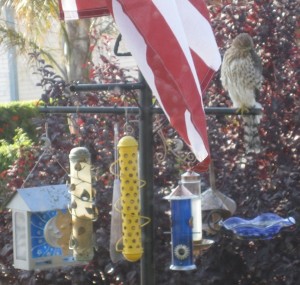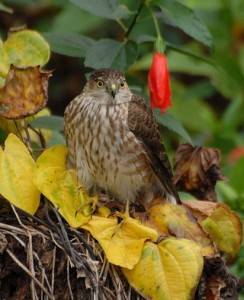-
A Different Breed of Hopper Bird Feeders
Would you file this one under hopper feeders? Because it’s definitely not a tube style, nor a platform (although it does have one). Do you think birds know about “thinking outside of the box”? They must have some clue, because instead of eating downward in natural fashion, they eat upward with this feeder. Huh? That’s what we first thought too… until we saw it in action!
The All-Weather Feeders are truly an innovation in wild bird feeding. These hopper bird feeders absolutely keep seed dry in the most horrid conditions, and only dispense seed that’s required at a particular time – for that particular bird. Ten seed ports installed on the underside of the big hopper are totally protected from the elements… even sideways rain! Birds use the tray to land and perch, while feeding from above, allowing you full view of all feeding birds. The tray is also useful for acclimating birds while the feeder is still new to them. Additional treats (like shelled peanuts or suet chunks) may also be used on the tray itself to further entice feathered friends.
Available in four or six-quart capacity, the All-Weather Feeder offers an optional pole mount attachment too. Black oil sunflower or a safflower/sunflower mix tends to work best. The seed ports are too small for striped sunflower seed. Made of sturdy polycarbonate that won’t yellow over time, the feeder also comes with a full ten year guarantee against breakage.
No more cleaning out wet seed after rain and snow (when birds depend most on a constant food source). 100% weather-proof feeder keeps seed dry and available at all times, no matter the weather! Truly an innovation in wild bird feeding, it just goes to show that all hopper bird feeders are not created equal!
-
Something a bit more fun than hopper bird feeders
So many wild bird feeders yet so little time!
With summer months come new visitors, the exotics and migratory birds who winter in South and Central America. Recently we had the coolest family of Catbirds, their calls are most intriguing, one could sit and listen for hours if time allowed. A lone Oriole passed through, and a Painted Bunting proved for some real eye candy. Of course, one of our all-time favorites, hummingbirds showed up a few weeks early this year too.
None of these birds are likely to check out our boring hopper bird feeders, so the variety offered is a good way to entice more beaked buddies. Fresh water in a birdbath is also an excellent way to attract more birds too.
This handcrafted number is made from stoneware and bamboo to ensure many seasons of use. There’s a small hopper for a cache of peanuts or larger seed mixes, hollow logs for stuffing suet treats, and a stoneware ring for an ear of corn… now that’s variety! Standard suet cakes may be cut into sections for filling the logs, and plenty of dough type suets are available. They’re easy to scoop out and pliable for inserting. Although Mr. Jay is shown here, lots of other species are bound to check out the cool design with multiple offerings.
But should you still be stuck on traditional hopper style feeders, one can
still be creative with a kit like this one. Sturdy cedar means this feeder will be around for years, and imagination is the limit. Paint it in bold, fun colors or add an interesting stain. Then your boring hopper bird feeder is anything but mundane!
-
Hawks at your wild bird feeders? me too :(
A customer in California sent in this photo shortly after receiving the wild bird feeders she had ordered. The two blue celestial theme bird feeders, yellow peanut feeder, and blue wavy birdbath are from us… the hawk was not! Vickie snapped this photo from inside her living room, but by the looks of the flag waving right in front of him, this Cooper’s Hawk would’ve likely been unfazed by any photo op!
A friend recently posted on Facebook too: “To feed or not to feed?” After he witnessed multiple accounts of a Sharp-Shinned Hawk picking off doves around his wild bird feeders.
And me too, on one of the list-serves I recently inquired about hawks at around my feeders. A few precautions and solutions were offered. One of them was to hang wild bird feeders from the interior limbs of trees. The outer limbs will act as a barrier for hawk attacks. The person also said he likes feeding various sparrows and other ground-feeding birds. To protect them from hawks (and cats) he uses tomato cages laid flat on the ground. This gives the birds many entry and exit choices, while keeping them safe from predators.
When asked what kind of hawk was in my yard… I had to research it. The Cooper’s and Sharp-Shinned Hawk look pretty much identical, unless you happen to see them side by side. Although their hunting habits are different, it’s really tough to tell the two apart! According to a wikipedia article by Matt Edmonds: “Cooper’s Hawks are barrel shaped, with the width of the chest fairly close in size to the width of the hips and the largest portion of the chest about halfway down the body. Sharp-shinned Hawks, on the other hand, are widest at the shoulder and get distinctly narrower down to the hips.” You can the full article here: http://en.wikipedia.org/wiki/Sharp-shinned_Hawk
Oh yeah, and that cobalt celestial-looking wild bird feeder is actually called “Solstice”. It’s a cool hopper style feeder with large capacity and innovative perches, measuring 13 tall x 11 wide x 7.5 deep. It promises to entice feathered friends and keep them coming back. But should you see hawks around your yard, do the birds a favor and move it to a tree!






